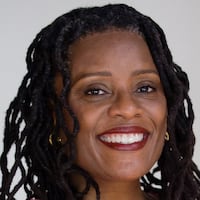EVENT PREVIEW
Art Party. 7 p.m.-midnight Oct. 19. After a 10-year hiatus, the popular fund-raising event returns to mark the 40th anniversary of the Atlanta Contemporary Art Center and unveil the center's renovations. Includes music, food, craft cocktails, studio tours and opening night for two exhibitions, "Fallen Fruit" and "Energy Strategies." $50 advance; $60 at door; $25 members.
EXHIBITIONS
"Fallen Fruit." An installation of wallpaper, paintings, videos, photographs and other works that explore the nature of the South through fruit by the Los Angeles-based collective of David Burns and Austin Young. Oct. 19-Dec. 14.
"Energy Strategies." Atlanta artist Steven L. Anderson's meditative space installation will include rugs and pillows, text-based drawings, videos and sound. Oct. 19-Dec. 14.
UPCOMING EVENTS
Contemporary Talks. Author and art historian Kellie Jones and her mother, poet and author Hettie Jones, discuss the creative process. Free. 11 a.m. Oct. 26.
Halloween Program. A candlelight event with art Karen Tauches. Free. 6:30 p.m. Oct. 31.
Atlanta Contemporary Art Center. 11 a.m.-5 p.m., Tuesdays-Saturdays. $8. 535 Means St. NW, Atlanta. 404-688-1970, www.thecontemporary.org
Four years ago, curators hung a vintage white Mustang from the rafters of the Atlanta Contemporary Art Center.
The car, part of artist Mark Wentzel’s piece, “Morale Hazard,” dangled above the concrete floor from a Herculean chain. The steel girder supporting the coupe seemed to groan.
Months before, Contemporary artistic director Stuart Horodner allowed architects David Yocum and Brian Bell to slice out a section of an exterior wall for their piece, “Boundary Issues.” The opening, half below ground level and half above, was the size of a large patio sliding door. The giant pane of glass they installed gave a view of dark soil on the bottom and sky along the top.
Horodner wasn't being cavalier about the integrity of the building. But the space was in need of renovation, and the presentation of those works of art was so specific, he was willing to tinker with the structure, a converted, early 20th century industrial building.
After this week, Horodner might be more reticent.
On Oct. 19, the Contemporary celebrates its 40th anniversary and unveils its first major renovation in 24 years — a $600,000 overhaul of the main gallery space, which began in July. It is the first building on the 30,000-square-foot Means Street campus to be freshened up. Contemporary officials see it as the start of a multi-year project to give the center the sort of sophisticated home they say it deserves.
The milestone also marks the return of Art Party, the Center’s once signature fundraising — and sometimes hair-raising — event. As the center went through a succession of directors and financial challenges, the party went into hiatus for 10 years. Now, like the institution it benefits, it’s ready to make a splash on the city’s arts scene once again.
“When you don’t worry so much about the building, you can do things like hang a Mustang from the ceiling or cut a hole in the wall,” Horodner said during a recent tour of the renovated space. “I don’t want to be too precious about it, but it’s almost scary to think about that now. We bowled them over with art, now the building can bowl them over. That’s a card we’ve never been able to play.”
Ready for its closeup
Horodner doesn’t come across as easily excitable. But walking through the space on a recent weekday morning with managing director Stacie Lindner and Yocum, one of the renovation architects, Horodner’s excitement grew with each step he took. The renovation was nearing its later stages. Saws buzzed. Dust swirled.
“How cool is this place,” Horodner said.
What was once a dark warren of smaller exhibition spaces and ad hoc areas for events was being transformed into a gleaming, polished, white space. Walls were being painted. Windows long boarded up to make room for art were being uncovered. New windows were being installed near the entry, providing a view of the courtyard outside. Where card tables served as refreshment stands, now there was a proper bar and prep area. What had been a storage closet, tiny artist studio and small exhibition space, was now a roomy lecture hall. And for anyone who ever had to use a restroom in the previous space, they would likely have been relieved to see brand-new facilities.
“We got a $150,000 two-year grant from the Warhol Foundation for exhibitions and programs and that’s a credibility you can’t buy,” said Lindner.
Before she could complete her thought, Horodner jumped in.
“But the building, as it was, didn’t engage that level of seriousness,” Horodner said. “It’s the building and the programs that need to be in lock step.”
Less than 400-square-feet of exhibition space was sacrificed in the redesign of the 14,000-square-foot gallery, said Yocum, who, along with Bell, are principals of the Atlanta architecture firm BLDGS.
"We've let more natural light in and taken advantage of the volume and bones of the space," he said.
As much as the refurbishment is a story of aspiration, of wanting a facility that is on par with other highly respected contemporary galleries around the country, it is also a story of making do with less. Making do is something the Contemporary has had to do throughout its 40-year history.
Ambitious beginnings
It began in 1973 as a photography cooperative that, over time, called itself Nexus. Housed in an old school house on Ralph McGill Boulevard, it offered gallery space, artists’ studios and an offset print shop called Nexus Press, which produced artist books. By 1983, the venerable Louise Shaw, a Massachusetts transplant and curator, had taken the helm of the organization, which came to be known as the Nexus Contemporary Arts Center. Over the next 15 years she built it into the city’s edgiest arts institution and one of the region’s most respected contemporary arts outfits. Local artists on the brink of a breakthrough could find a home there. It also brought a wealth of national and international talent to Atlanta audiences. Shaw created Art Party as an outlandish, see-and-be-seen fundraiser.
It was under Shaw that the Contemporary moved in the late 1980s to its current home, a former truck depot, on Means Street, near Georgia Tech. Shaw retired in 1998, and a new executive director took over.
By 2000, Nexus had changed its name to the Atlanta Contemporary Art Center and entered a period of financial instability and artistic decline. A new director and former Contemporary board member, Rob Smulian, took over in 2002. Under his watch he trimmed the Contemporary’s budget, erased its $250,000 debt, boosted its membership, shutdown Nexus Press and helped the organization regain its credibility and viability.
Horodner became artistic director in 2007. He brought in artists such as Demetrius Oliver and Jennie C. Jones, and he began a program offering critiques to local, up-and-coming artists. A robust lecture series drew regular audiences.
But the building was showing its age and its inadequacy in properly showcasing work. The HVAC systems were by then nearly 20 years old. Sculptures and drawings were illuminated with clip-on spotlights. With no dedicated lecture hall, talks were wedged into small spaces separating galleries. And then there were those bathrooms.
Just two years into Horodner’s term the recession kicked in. Arts organizations saw their donations dip. The Contemporary’s operating budget hovered at $600,000. It got a 2010 Non-Profit Toolbox grant from The Community Foundation for Greater Atlanta to assess expansion options. One recommendation was for a campus-wide overhaul costing $5 million to $7 million.
“People would come in, see shows but not go away with a highly favorable view of the facility itself,” said Contemporary board chair Tim Schrager. “The center wasn’t in the position to raise $7 million, even with a generous, lead donor.”
That’s when Bell and Yocum were brought in and given a budget of $600,000 — the equivalent of the center’s annual operating budget — to revamp just the gallery. The other buildings on the campus, including artists’ studios and the skeletal remains of a warehouse used as a pavilion for outdoor programming, would have to wait.
The board’s decision to scale back its ambition showed “strong leadership,” said Lisa Cremin, director of the Community Foundation for Atlanta. “Incremental steps” is her recommendation for how small and midsized arts groups such as the Contemporary should move forward during a still-fragile economic recovery.
Schrager, a real estate developer, chaired the capital campaign. As of this month just over $400,000 had been raised, he said. It has been a tough sell to donors, despite the organization’s reputation, he said.
“I don’t want to say people didn’t believe we could pull it off, but it has been easier now that we can walk people in and they can see it,” he said.
The pavilion will come next, getting a new roof and reinforced frame. But re-doing the entire campus will take at least 10 years, he said.
For now, the Contemporary is focusing on what it has already accomplished. And with this gallery re-do they believe they’ve polished up the most important jewel in the setting.
“This is a strategic move to reaffirm this institution as part of the relevant dialogue,” said Yocum.
About the Author
Keep Reading
The Latest
Featured

